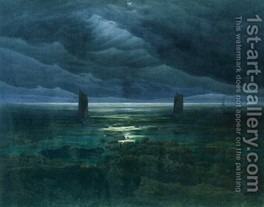German Romanticism was a profound period where literature and art floated in a state of efflorescence to celebrate the influence of the Middle Ages. Many painters and literary figures shouldered this movement, one of whom was Casper David Friedrich, the exemplary landscape genius.
Casper David Friedrich was known for his minuscule details beautifully infused in his renowned landscapes, exuding both grace and knowledge. One of his most lauded works was Seashore by Moonlight, a classic German Romanticism trademark, distinguished for its mystique.
The masterpiece tells many stories of nature, man, and religion which would not absorb in you unless you gawk deeply into the soul of it. So, to fully understand the psyche of Casper before painting it, we must go back in time and explore the underlying themes in it.
What Encompasses German Romanticism?
In comparison to the intense and serious English Romanticism, German Romanticism started way early and also, inched more towards wit, humor, and beauty. The early Germans found a muse in the Middle Ages which was seen as a simpler time, booming with rich culture.
Followers of this movement believed in curating a novel interpretation of art, philosophy, and science. German romanticism strived to break down the supernatural element which connected man and his daily life toils. Many critics berated the movement for uniting art and society based on a medieval period but it was anyway a success. There are so many amazing and different types of museusm in the world you can visit ranging from the Louvre in Paris to the Dallas Holocaust and Human Rights Museum.
Casper’s Style in His German Romanticism Masterpieces
Casper was a prominent presence in the period for German art due to his extraordinary interpretations of all things enveloping him. The background of his landscapes is misty, night skies, infertile trees, and basically along the lines of ruins.
His allegorical landscapes attempt to evoke an emotional response from the audience and offer disparate iterations of how we perceive nature. Often one can see a dark silhouette lingering in his landscape to view the figurine in a metaphysical dimension. He illustrates these ideas by playing with the elements of light and shadow, depicting an enormous contrast to narrate a tale of his own.
About the Seashore by Moonlight
This composition is a typical specimen of a German Romantic movement in art. While Romanticism was all about the glorification of nature in the most shallow sense of the word, this painting may be striking to you as it exudes a dark aura.
Like much of Friedrich’s work this painting to have an authentic religious message around which the whole theme of it swirls. The naturalist elements oozing out of this landscape depict a divine revelation.
This argument can be settled by pointing out the divine, unearthly light that seems to be showering on the sea from the heavens above. Friedrich’s seascapes beheld religious connotations as it directly related nature and man in a supernatural way, making the onlookers feel closer to home in the wilderness in front of them.
Description of the Masterpiece
This painting is rich in naturalistic scenery which is commonplace like a seashore with green moss covering the end of it. The mosses dance on the blue water denoting that they are almost one but never so. Some enormous boats seem to be approaching the seashore to denote man on water, surrendering his destiny to the almighty nature.
Moreover, the foreground of the masterpiece seems to be darker than the background itself which is depicted in an utterly serene way. The parade of clouds seems to be merging, such is their consistency and depth. The clouds are masking the beautiful moon shining on top of the canvas whose eternal light can be only seen reflected in the water.
Let’s Take a Closer Look At The Painting
Now, this illustration we see is more than its description in terms of depth. What people miss is the glorious symmetry created out of a miscellany of vertical and horizontal forms that fabricate an atmosphere of meditation. The color palette employed here is scant but is used with utmost subtlety and grace to denote a mix of earthy and unearthly forms.
The supernatural light shining from above seems to be catching up with the boats which are a symbol of human turmoil, hence, portraying a union of the two elements. The fishing boat communicates the fragility of the human condition which is subject to wear and tear.
Also, the stranded boat speaks of an impending death that looms like a dark cloud over the head of all mankind. This is when the metaphor of a supernatural presence of the light, which is seen as Christ, comes in bearing the name of “savior of mankind.” These elements interspersed give this German Romantic seascape its real character.
The Bottom Line
German Romanticism was birthed before its English counterpart and flourished in the early parts of the 18-19th century. This movement was bookmarked in history, courtesy to artists like Casper David Friedrich who unearthed distinct views on nature and man, offering trailblazing explanations. Seashore by Moonlight is one such beautiful outcome of this thinking which harbors religious and divine connotations, giving the painting an unreal and ahead of its time depth.
